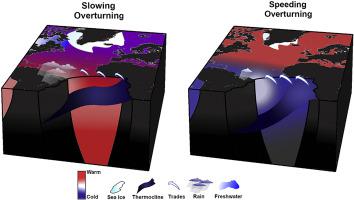当前位置:
X-MOL 学术
›
Quat. Sci. Rev.
›
论文详情
Our official English website, www.x-mol.net, welcomes your
feedback! (Note: you will need to create a separate account there.)
Freshwater forcing control on early-Holocene South American monsoon
Quaternary Science Reviews ( IF 3.2 ) Pub Date : 2020-10-01 , DOI: 10.1016/j.quascirev.2020.106498 Wilton Aguiar , Luciana F. Prado , Ilana Wainer , Zhengyu Liu , Alvaro Montenegro , Katrin J. Meissner , Mauricio M. Mata
Quaternary Science Reviews ( IF 3.2 ) Pub Date : 2020-10-01 , DOI: 10.1016/j.quascirev.2020.106498 Wilton Aguiar , Luciana F. Prado , Ilana Wainer , Zhengyu Liu , Alvaro Montenegro , Katrin J. Meissner , Mauricio M. Mata

|
Abstract Climate anomalies due to Lake Agassiz outbursts and Hudson Bay ice dome melting are commonly considered triggers of North American atmospheric cooling. However, in the Southern Hemisphere, these freshwater fluxes are mostly associated with increased precipitation and a possible intensification of the South American Monsoon System (SAMS). Here, we tested how the SAMS responded to early-Holocene meltwater events. Based on both proxy data and simulations, we find that sea surface temperatures (SSTs) and precipitation indicate a freshwater-driven strengthening of the SAMS due to a weakening of the South Atlantic subtropical dipole. Simulated SAMS strengthening accounts for up to 50% of the variance in early-Holocene precipitation in South America. In turn, changes in the South Atlantic Subtropical Dipole accounts for up to 31% of the variance in South Atlantic SSTs. Additionally, we propose that the stronger SAMS in the early Holocene might have been due to a freshwater-driven weakening of the southeasterly trade winds. Slower trade winds weaken the zonal and meridional surface water transport, concentrating warm waters in the northeastern South Atlantic.
中文翻译:

淡水强迫对早全新世南美季风的控制
摘要 由于阿加西湖爆发和哈德逊湾冰穹融化引起的气候异常通常被认为是北美大气变冷的触发因素。然而,在南半球,这些淡水通量主要与降水增加和南美季风系统 (SAMS) 可能加强有关。在这里,我们测试了 SAMS 如何应对全新世早期融水事件。基于代理数据和模拟,我们发现海面温度 (SST) 和降水表明,由于南大西洋副热带偶极子的减弱,淡水驱动的 SAMS 加强。模拟的 SAMS 强化占南美洲早期全新世降水差异的 50%。反过来,南大西洋副热带偶极子的变化占南大西洋海温变化的 31%。此外,我们认为全新世早期更强的 SAMS 可能是由于淡水驱动的东南信风减弱。较慢的信风削弱了纬向和经向地表水运输,使南大西洋东北部的暖水集中。
更新日期:2020-10-01
中文翻译:

淡水强迫对早全新世南美季风的控制
摘要 由于阿加西湖爆发和哈德逊湾冰穹融化引起的气候异常通常被认为是北美大气变冷的触发因素。然而,在南半球,这些淡水通量主要与降水增加和南美季风系统 (SAMS) 可能加强有关。在这里,我们测试了 SAMS 如何应对全新世早期融水事件。基于代理数据和模拟,我们发现海面温度 (SST) 和降水表明,由于南大西洋副热带偶极子的减弱,淡水驱动的 SAMS 加强。模拟的 SAMS 强化占南美洲早期全新世降水差异的 50%。反过来,南大西洋副热带偶极子的变化占南大西洋海温变化的 31%。此外,我们认为全新世早期更强的 SAMS 可能是由于淡水驱动的东南信风减弱。较慢的信风削弱了纬向和经向地表水运输,使南大西洋东北部的暖水集中。











































 京公网安备 11010802027423号
京公网安备 11010802027423号